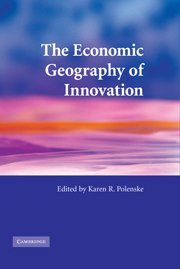Book contents
- Frontmatter
- Contents
- List of figures
- List of tables
- Notes on contributors
- Acknowledgments
- Abstracts
- List of abbreviations and acronyms
- Part I Concepts and measurements in innovation
- Part II Institutional and spatial aspects of information and knowledge flows
- Part III Institutions and innovation systems
- 10 National systems of production, innovation, and competence building
- 11 Perspectives on entrepreneurship and cluster formation: biotechnology in the US Capitol region
- 12 Facilitating enterprising places: the role of intermediaries in the United States and United Kingdom
- 13 Innovation, integration, and technology upgrading in contemporary Chinese industry
- 14 Society, community, and development: a tale of two regions
- Index
- References
13 - Innovation, integration, and technology upgrading in contemporary Chinese industry
Published online by Cambridge University Press: 22 September 2009
- Frontmatter
- Contents
- List of figures
- List of tables
- Notes on contributors
- Acknowledgments
- Abstracts
- List of abbreviations and acronyms
- Part I Concepts and measurements in innovation
- Part II Institutional and spatial aspects of information and knowledge flows
- Part III Institutions and innovation systems
- 10 National systems of production, innovation, and competence building
- 11 Perspectives on entrepreneurship and cluster formation: biotechnology in the US Capitol region
- 12 Facilitating enterprising places: the role of intermediaries in the United States and United Kingdom
- 13 Innovation, integration, and technology upgrading in contemporary Chinese industry
- 14 Society, community, and development: a tale of two regions
- Index
- References
Summary
Introduction
China's extraordinary economic transformation over the past two decades has been linked inextricably with the nation's broader process of technological upgrading, industrial restructuring, and integration into the global economy. Beijing's initial policy of “opening up,” by permitting inflows of knowledge and information, underscored for domestic observers China's relative economic backwardness (thus raising expectations for reform) while at the same time providing the sorts of overseas contacts needed by nascent industrial firms to link up with international supply chains (thus initiating the sorts of organizational change that alleviate economic backwardness). Domestic institutional and organizational reform, in turn, has enabled Chinese producers over time to deepen their engagement with outside markets, leading to growth outcomes that not only accelerate societal transformation, but also raise popular expectations and imperatives for further reform.
This chapter examines the limits and sustainability of this “virtuous cycle.” Chinese firms unquestionably are now major players in global production, but can these firms organizationally develop the sort of innovative capacities that lead to long-term competitiveness? What have the obstacles been to date?
The question is particularly challenging since China's domestic modernization process is hardly the only variable in play. Instead, the international system itself, particularly the manner by which manufacturing activity is structured globally, has changed dramatically in recent years. Technological advances, especially those associated with digitization and modularization, have permitted at least some complex production processes – the kinds of processes that previously took place within single integrated firms – to be split into discrete activities, spread out across multiple firms, and dispersed across great geographical expanses (Baldwin and Clark 2000).
- Type
- Chapter
- Information
- The Economic Geography of Innovation , pp. 289 - 309Publisher: Cambridge University PressPrint publication year: 2007
References
- 3
- Cited by



